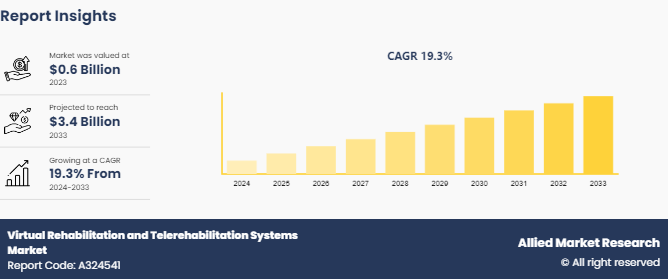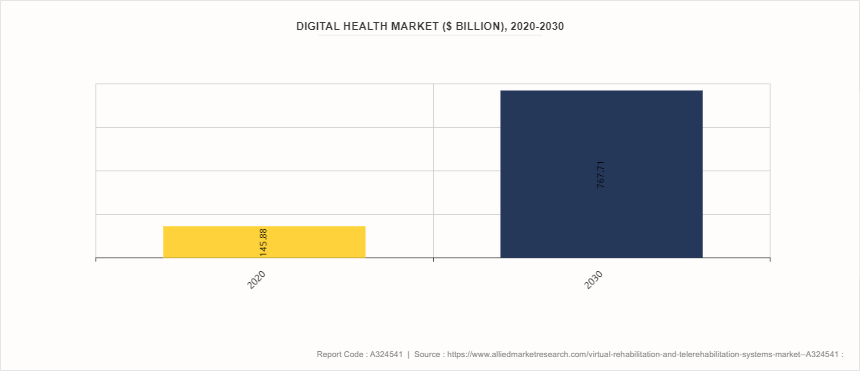Virtual Rehabilitation and Telerehabilitation Systems Market Research, 2033
The global virtual rehabilitation and telerehabilitation systems market size was valued at $0.6 billion in 2023, and is projected to reach $3.4 billion by 2033, growing at a CAGR of 19.3% from 2024 to 2033. The major factor driving the growth of the market are technological advancement, rise in adoption of the digital healthcare technologies and growwing prevalence of chronic diseases.

Market Introduction and Definition
Virtual rehabilitation and telerehabilitation systems are innovative approaches that leverage technology to deliver therapy and rehabilitation services remotely. Virtual rehabilitation typically involves the use of virtual reality (VR) or augmented reality (AR) environments to simulate real-world scenarios or exercises tailored to the needs of patients undergoing rehabilitation. These systems can provide interactive experiences that enhance engagement and motivation, crucial factors in effective rehabilitation outcomes. By immersing patients in virtual environments, therapists can monitor progress, adjust exercises in real-time, and provide immediate feedback, thus personalizing treatment plans more effectively. Telerehabilitation, on the other hand, encompasses a broader range of remote rehabilitation services that can include not only VR/AR but also teleconferencing, mobile apps, and wearable devices. It allows therapists to deliver therapy sessions, monitor progress, and provide consultations from a distance, overcoming barriers such as geographical distance, transportation challenges, or limitations due to physical disabilities. Telerehabilitation systems often incorporate secure communication channels and data tracking features to ensure patient confidentiality and effective monitoring of rehabilitation progress over time. The major factors driving the growth of the virtual rehabilitation and telerehabilitation systems market are high adoption of digital healthcare technology, increasing prevalence of chronic diseases, and technological advancement in the virtual and augment reality technology.
Key Takeaways
- The virtual rehabilitation and telerehabilitation systems market share study covers 20 countries. The research includes a segment analysis of each country in terms of value for the projected period.
- More than 1, 500 product literatures, industry releases, annual reports, and other such documents of major virtual rehabilitation and telerehabilitation systems industry participants along with authentic industry journals, trade associations' releases, and government websites have been reviewed for generating high-value industry insights.
- The study integrated high-quality data, professional opinions and analysis, and critical independent perspectives. The research approach is intended to provide a balanced view of global markets and assist stakeholders in making educated decisions to achieve their most ambitious growth objectives
Key Market Dynamics
According to virtual rehabilitation and telerehabilitation systems market forecast analysis the key factors driving the growth of the market are aging population, rising prevalence of chronic diseases, technological advancement, and increased adoption of telehealth. As the global population ages, there is an increasing prevalence of age-related health conditions such as stroke, arthritis, and other chronic diseases that require long-term care and rehabilitation. According to 2024 article by National Library of Medicine, virtual reality (VR) therapies are currently being used to address physical and cognitive dysfunctions in elderly populations. Elderly individuals often face mobility challenges and other physical limitations that make traditional in-person rehabilitation sessions difficult or inconvenient. Virtual rehabilitation and telerehabilitation systems provide a flexible and accessible solution, allowing older adults to receive therapy in the comfort of their homes. These systems leverage advanced technologies like virtual reality, motion-sensing devices, and telecommunication tools to deliver effective rehabilitation programs remotely. Moreover, these technologies facilitate continuous monitoring and personalized care, addressing the specific needs of geriatric patients. Thus, the rise in geriatric population is expected to drive the virtual rehabilitation and telerehabilitation systems market growth.
According to virtual rehabilitation and telerehabilitation systems market trends analysis, the increased adoption of telehealth is expected to drive the growth of the market. This trend is fueled by several factors, including the increasing prevalence of chronic diseases, the growing aging population, and the need for continuous and personalized rehabilitation services. Telehealth enables healthcare providers to extend their reach, offering remote monitoring and therapy to patients who might otherwise face barriers to accessing traditional in-person rehabilitation services, such as geographical limitations or mobility issues. The convenience, flexibility, and cost-effectiveness of telehealth solutions are highly attractive to both patients and healthcare providers. Moreover, advancements in technology, such as improved internet connectivity, the proliferation of smartphones, and the development of sophisticated software and hardware for virtual interactions, have enhanced the effectiveness and appeal of telehealth-based rehabilitation. Thus, the rise in adoption of the digital health solution is expected to drive the growth of virtual rehabilitation systems market.
Parent Market Overview- Digital Health Market
Digital health market is parent market of virtual rehabilitation and telerehabilitation systems market. The global digital health market size was valued at $145, 884.3 million in 2020, and is projected to reach $767, 718.9 million by 2030, registering a CAGR of 17.9% from 2021 to 2030. Digital health products and services encompass a broad range of technologies and applications aimed at improving healthcare delivery, patient outcomes, and overall health management through digital means. These include telemedicine platforms, mobile health applications (mHealth) , wearable devices, and health information technology systems. Telemedicine allows patients to consult healthcare professionals remotely, increasing access to care and convenience, particularly in underserved areas. Mobile health apps enable users to track their health metrics, manage chronic conditions, and access health information, promoting proactive health management. Wearable devices, such as fitness trackers and smartwatches, monitor physical activity, heart rate, sleep patterns, and other vital signs, providing real-time health data to users and healthcare providers. Health information technology systems, including electronic health records (EHRs) and health information exchanges (HIEs) , facilitate the efficient storage, retrieval, and sharing of patient information among healthcare providers, enhancing coordination and continuity of care.
Virtual rehabilitation utilizes virtual reality (VR) and augmented reality (AR) technologies to create immersive environments for physical and cognitive therapy, offering patients interactive and engaging ways to complete their rehabilitation exercises. These systems can simulate real-world scenarios, providing a safe and controlled setting for patients to practice and improve their skills. Telerehabilitation, however, extends traditional rehabilitation services to remote settings through telecommunication technologies. This approach enables therapists to deliver treatment plans, monitor progress, and provide feedback to patients in real time, regardless of their location. Both virtual rehabilitation and telerehabilitation enhance accessibility to rehabilitation services, reduce the need for in-person visits, and support continuous patient engagement, contributing to better recovery outcomes and improved quality of life for patients.

Market Segmentation
The virtual rehabilitation and telerehabilitation systems industry is segmented into type, end user, and region. By type, the market is divided into physical rehabilitation, neuro rehabilitation, cognitive rehabilitation, and other rehabilitations. By end user, the market is classified into hospitals, care homes, and others. Region wise, the market is analyzed across North America, Europe, Asia-Pacific, and LAMEA.
Regional/Country Market Outlook
North America dominated the virtual rehabilitation and telerehabilitation systems market share in 2023, owing to substantial research and development activities, a strong presence of major technology firms, and widespread adoption of advanced healthcare technologies. According to the virtual rehabilitation and telerehabilitation systems market opportunity analysis Asia-Pacific region is expected to witness rapid market expansion owing to rising healthcare expenditure, increasing awareness of virtual rehabilitation and telerehabilitation technology, and rise in geriatric population.
- Some of the major players in North America are Reflexion Health, Inc (U.S.) , 270 Vision Ltd., Hinge Health, Inc, Bridgeway Senior Healthcare, and Virtualware Group.
- According to 2021 article by National Library of Medicine, 73% of U.S. hospitals had at least one telehealth capability. More than half of these hospitals invested in telehealth consultation services and stroke care.
- According to United Nations Population Fund the elderly population (aged 60 and above) in India is 153 million as of 2023 and is expected to reach 347 million by 2050
Industry Trends
- According to 2023 article by National Library of Medicine, Telerehabilitation (TR) is a viable and feasible solution to face the rehabilitative challenges posed by neurological impairments and to improve patients’ quality of life (QoL) . This recognition is expected to catalyze substantial growth within the virtual rehabilitation and telerehabilitation systems market size.
- The American Physical Therapy Association (APTA) in 2024 has published a new clinical practice guideline (CPG) titled "Telerehabilitation in Physical Therapist Practice" in its science journal PTJ: Physical Therapy & Rehabilitation.
- According to 2021 article by Now Health International, an international private medical insurance provider, 80% of people have accessed care via telemedicine at least once in their lives. Telemedicine's acceptance reflects a growing comfort with remote healthcare delivery, leveraging technology to enhance patient care accessibility and convenience. This trend is likely to boost demand for virtual rehabilitation systems, which offer remote monitoring, therapy, and rehabilitation services through digital platforms. Thus, the rise in the adoption of the virtual rehabilitation systems and telemedicine is expected to drive the growth of the virtual rehabilitation systems market.
Competitive Landscape
The major players operating in the virtual rehabilitation and telerehabilitation systems market include Reflexion Health, Inc, 270 Vision Ltd, CoRehab srl, Hinge Health, Inc, SWORD Health, S.A., MIRA Rehab Limited, Bridgeway Senior Healthcare, Motekforce Link, GestureTek Inc, and Virtualware Group. Other players in the virtual rehabilitation and telerehabilitation systems market are Motorika Medical Ltd., LiteGait, and Mindmaze.
Recent Key Strategies and Developments
- In February 2021, EvolvRehab, a developer of rehabilitation technology solutions, launched a virtual therapy software platform called EvolvRehab and a hardware unit called RehabKit that connects to a television. This system allows patients to perform video game-like activities called exercise games, which are prescribed by therapists who can remotely monitor patient compliance and performance through the system.
Key Sources Referred
- Government of India
- National Library of Medicine
- Center of Disease Control and Prevention
- United Nations Population Fund
- Now Health International
- World Health Organization
- American Physical Therapy Association
Key Benefits for Stakeholders
- This report provides a quantitative analysis of the Virtual rehabilitation and telerehabilitation systems market segments, current trends, estimations, and dynamics of the virtual rehabilitation and telerehabilitation systems market analysis from 2023 to 2033 to identify the prevailing Virtual rehabilitation and telerehabilitation systems market opportunities.
- The market research is offered along with information related to key drivers, restraints, and opportunities.
- Porter's five forces analysis highlights the potency of buyers and suppliers to enable stakeholders make profit-oriented business decisions and strengthen their supplier-buyer network.
- In-depth analysis of the virtual rehabilitation and telerehabilitation systems market segmentation assists to determine the prevailing market opportunities.
- Major countries in each region are mapped according to their revenue contribution to the global Virtual rehabilitation and telerehabilitation systems market statistics.
- Market player positioning facilitates benchmarking and provides a clear understanding of the present position of the market players.
- The report includes the analysis of the regional and global virtual rehabilitation and telerehabilitation systems market trends, key players, market segments, application areas, and market growth strategies
Virtual Rehabilitation and Telerehabilitation Systems Market , by Type Report Highlights
| Aspects | Details |
| Market Size By 2033 | USD 3.4 Billion |
| Growth Rate | CAGR of 19.3% |
| Forecast period | 2024 - 2033 |
| Report Pages | 280 |
| By Type |
|
| By End User |
|
| By Region |
|
| Key Market Players | GestureTek Inc., Reflexion Health, Inc, Hinge Health, Inc, MIRA Rehab Limited, CoRehab srl, Sword Health, S.A, Motekforce Link, Virtualware Group, 270 Vision Ltd, Bridgeway Senior Healthcare |
The total market value of Triamcinolone Market is $0.6 billion in 2023.
The market value of Triamcinolone Market in 2033 is $3.4 billion.
The forecast period for Triamcinolone Market is 2024-2033.
The base year is 2023 in Triamcinolone Market
Major key players that operate in the Triamcinolone Market are Reflexion Health, Inc, 270 Vision Ltd, CoRehab srl, and Hinge Health, Inc
Loading Table Of Content...


